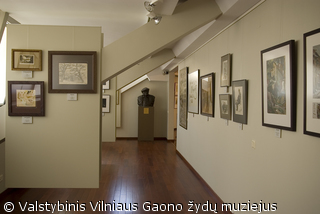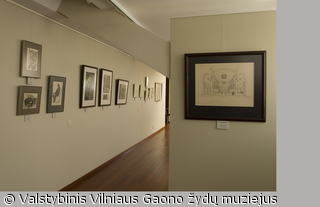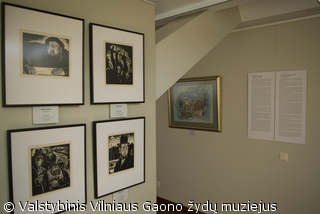| | Encounters: Litvak Art of XX-XXI centuries |
| The 20th century was the time of great changes: new states emerged, empires crumbled, the old Europe was ravaged by wars. Progress in medicine, sciences and technologies determined the appearance of new artistic trends, as social changes and the challenges humankind was faced with influenced art trends too: modernism was born. Perfectly completed lines were not enough to express inner feelings and the traumas experienced during the wars. In visual arts futurism, constructivism, expressionism with searches for popular fauvism, expansion of colours, abstractionism that gradually grew into postmodernist art took the leading position. The renewed exposition “The Lost World: Encounters” devoted to visual arts displays works created by Lithuanian Jewish artists at the beginning of the 20th and the first decade of the 21st century. The collection was formed over the last several years by the Vilna Gaon State Jewish Museum, implementing its mission, which is to collect and preserve for future generations works by Litvak artist scattered all over the world or created in the homeland. The works by distinguished artists and their biographies show that many names connected with foreign painters and graphic artists are part of Lithuanian culture. Many of the artists (whose works are still sold at famous world auctions) studied at the Vilnius Academy of Art, while the artists of the older generation attended the Vilnius Drawing School, the J. Vienožinskis drawing school in Kaunas. Some artists received their first lessons in art at the Vilnius Ghetto (Samuelis Bakas) or hiding in a poky little room in Paris during the Second World War with no sunlight for almost two years (Theo Tobiasse). |
 |
The 20th century united several generations of Litvak artists, but they were separated by the war and the geopolitical changes that took place after it. The painters of the older generation Pinchus Kremegne (1890-1981), Emmanuel Mané-Katz (1894-1962), Isaiah Kulviansky (1892-1970) whose names are connected with the Vilnius Drawing School (1866–1915), left Vilnius in the inter-war period and joined the ranks of West European artists. Kremegne’s and Mané-Katz’ names are connected with the l‘Ecole de Paris art school, Kulviansky’s name with Israeli artists: he became one of the founders of the Palestinian Association of Painters and Sculptors.
The middle generation artists connected with Vilnius are Rafael Chwoles (1913–2002), Bencion Michtom (1909–1941) and Rachel Sutzkever (1904–1943), they were active members of the Jung Vilne, the Jewish literature and art association. The life of Michtom (a constructivist, follower of the Bauhaus art movement) ended in Paneriai, Sutzkever was killed in Treblinka, while fate gave Chwoles the chance to follow in the footsteps of some Litvak artists: he settled in Paris, but all his works have the same motif – Vilnius with its Old Town little streets white with snow or lit by the sun as they were in his childhood where he used to wander.
|
|
Černė Percikovičiūtė (1912–?) and Neemiya Arbit Blatas (1908–1999) were students at the J. Vienožinskis private studio, while the Kaunas art school that grew out of the J. Vienožinskis drawing course, educated our contemporary Augustinas Savickas (1919–2012), who later graduated from the Vilnius Academy of Art, as well as contemporary Lithuanian artists Adomas Jacovskis (b. 1948) and Solomonas Teitelbaumas (b. 1972). Rich pastose strokes in Teitelbaumas’ works were created already in the 21st century. They are very expressive, with loud colours that convey the feelings experienced while working. Jacovskis’ pictures are full of metaphysic feelings: a profile on a monocoloured background and a left hand with an index finger pointing at the sky (“Profile on a Blue Background”, 1990), or a singing herald in a red space (“The Hymn”, 1990), holding the shofar. The herald’s head thrown back and teeth send into space a soundless cry and the question “why?” that has tortured humankind throughout centuries.
|
|
The century separates and again brings together Litvak artists. Samuel Bak (b. 1933) although connected with the war time Vilnius, is at the same time our contemporary, who presently lives in Massachusetts. His paitings with many surrealist elements, metaphysic figure compositions with their illustrating language raise questions about the world in which we live, try to find answers to the duality of the human nature that caused the most cruel crime of the 20th century, the Holocaust.
|
 |
|

|
At the exhibition, there is also a group of Litvaks, who beginning their artistic careers in Vilnius, later tied their lives with Israel: Isaiah Kulviansky, Yehezkel Streichman (1906-1993), and Moshe Rosenthalis (1922-2008). Theo Tobiasse (1927-2012) who was born to a family of Jewish immigrants in Israel should be attributed to this group. All of them have passed away, but are still among the most popular artists in Israel, who won state recognition and awards, influenced the art history of Israel (eg. Streichman, one of the founders of the New Horizons art movement). There is synthesis of painting and graphic in Rosenthalis’ works. His coloured lithograph “Composition with a Woman’s profile” is marked with a strong but disciplined line and several coloured patches, which makes the composition very expressive.
|
|
This text about the exhibition “The Lost World: Encounters” is just a light touch, several strokes trying to generalise the varied fates and works of 20th-century Litvaks who were scattered all over the world. Personal encounters and discoveries await visitors here, as well as during their wanders through the wide world‘s art galleries, suddenly reading the inscription near the biography of the artist: d‘origine lituanienne.
Ieva Šadzevičienė
Photography Paulius Račiūnas
|
| | Modified: 5/21/2015 |
|
| | | | | Information | | 2017.03.01 | |
|
If you want to order a guided tour or educational programme please contact us in advance:
tel. +370 60163612,
email: muziejus@jmuseum.lt
***
If you want to order an educational programme, please contact us at: +370 5 212 0112,
+370 6 8986 191 or via email muziejus@jmuseum.lt
***
Tolerance Center
(Naugarduko St. 10/2)
working hours:
Monday,Thursday: 10:00-18:00
Tuesday, Wednesday: 10:00-18:00
Friday: 10:00-16:00
Saturday-closed,
Sunday: 10:00-16:00
***
Holocaust Exposition
(Pamėnkalnio St. 12)
working hours:
Monday-Thursday: 9:00-17:00
Friday: 9:00-16:00
Saturday-closed
Sunday: 10:00-16:00
***
Memorial Museum of Paneriai
(Agrastų St. 15, Aukštieji Paneriai)
working hours:
Monday-closed
Tuesday–Sunday 9:00-17:00
From October until May the Memorial Museum is open by appointment only.
If you are interested in visiting the museum/the memorial with a tour guide, please contact us at least a day in advance at
+370 699 90 384 or via email mantas.siksnianas@jmuseum.lt
***
|
|
| | | | | | |  | |  |
|


